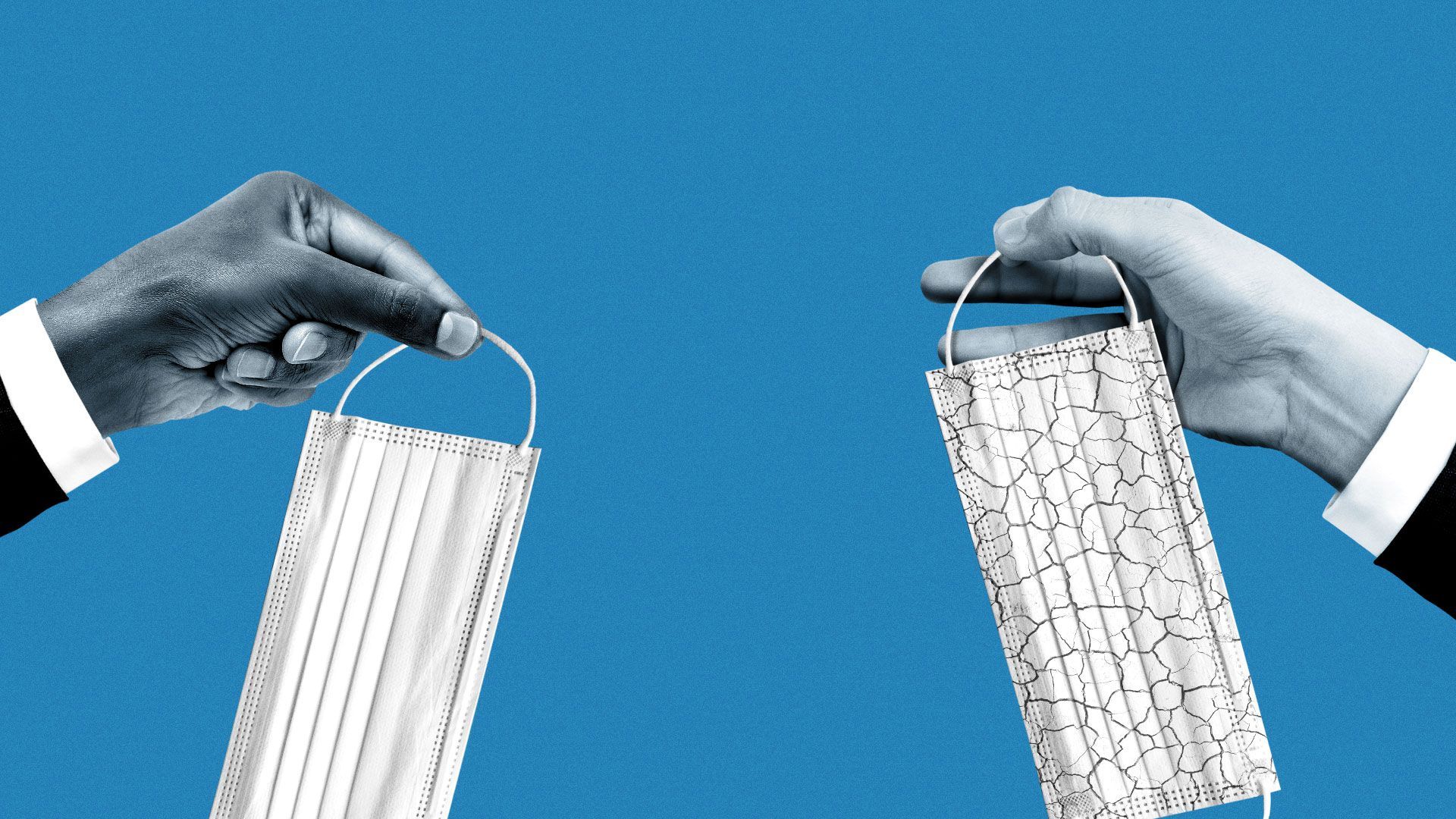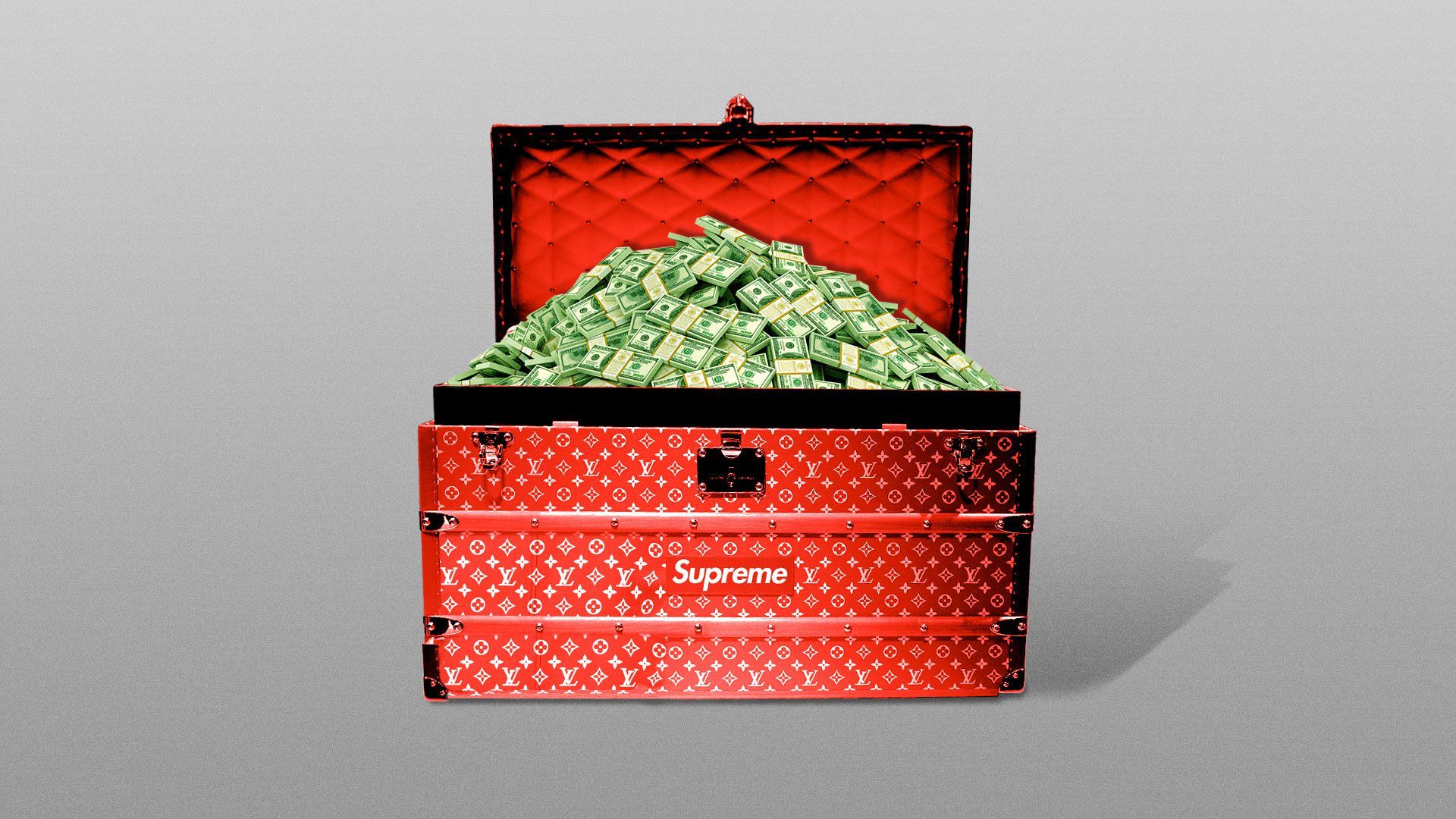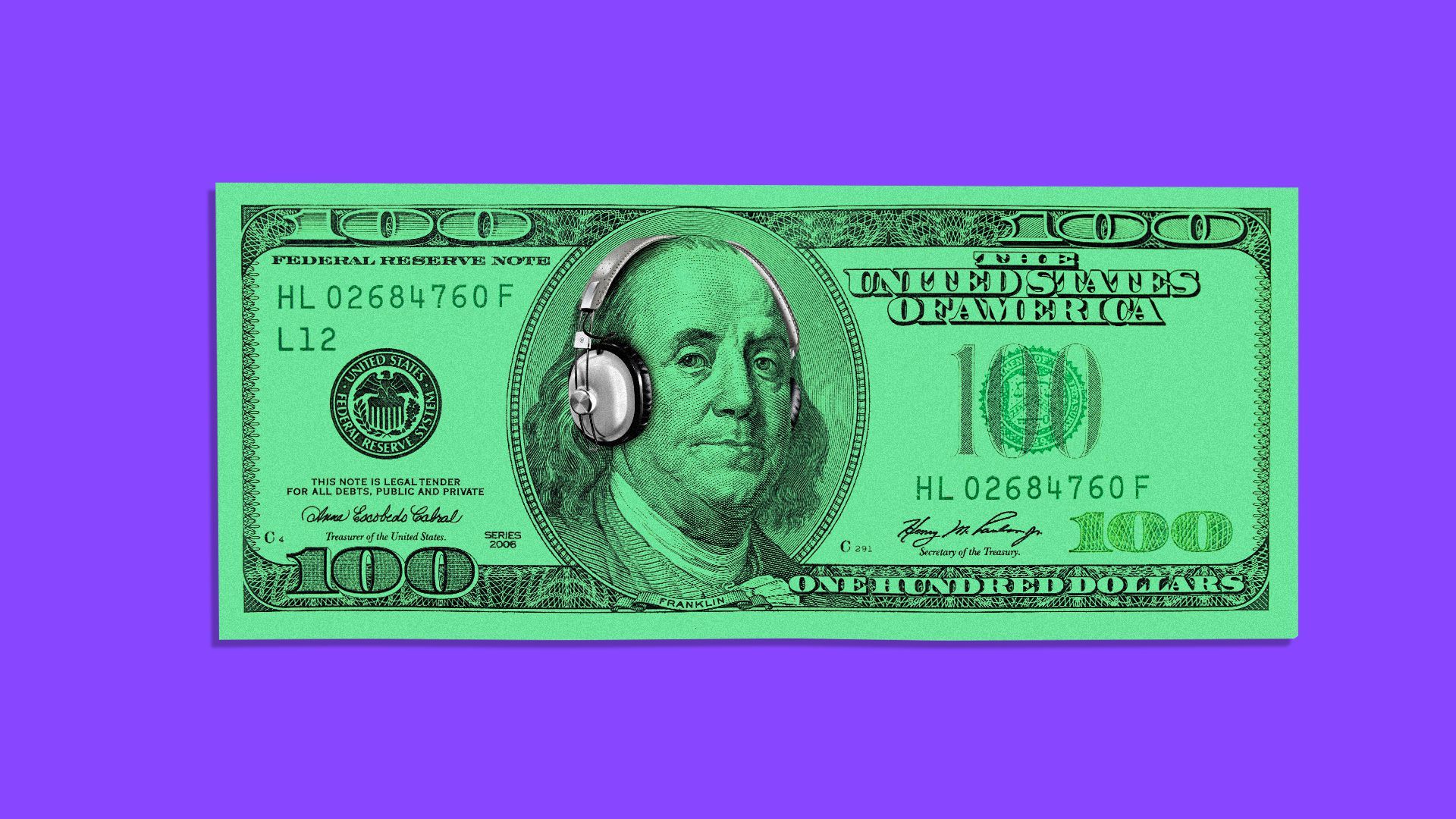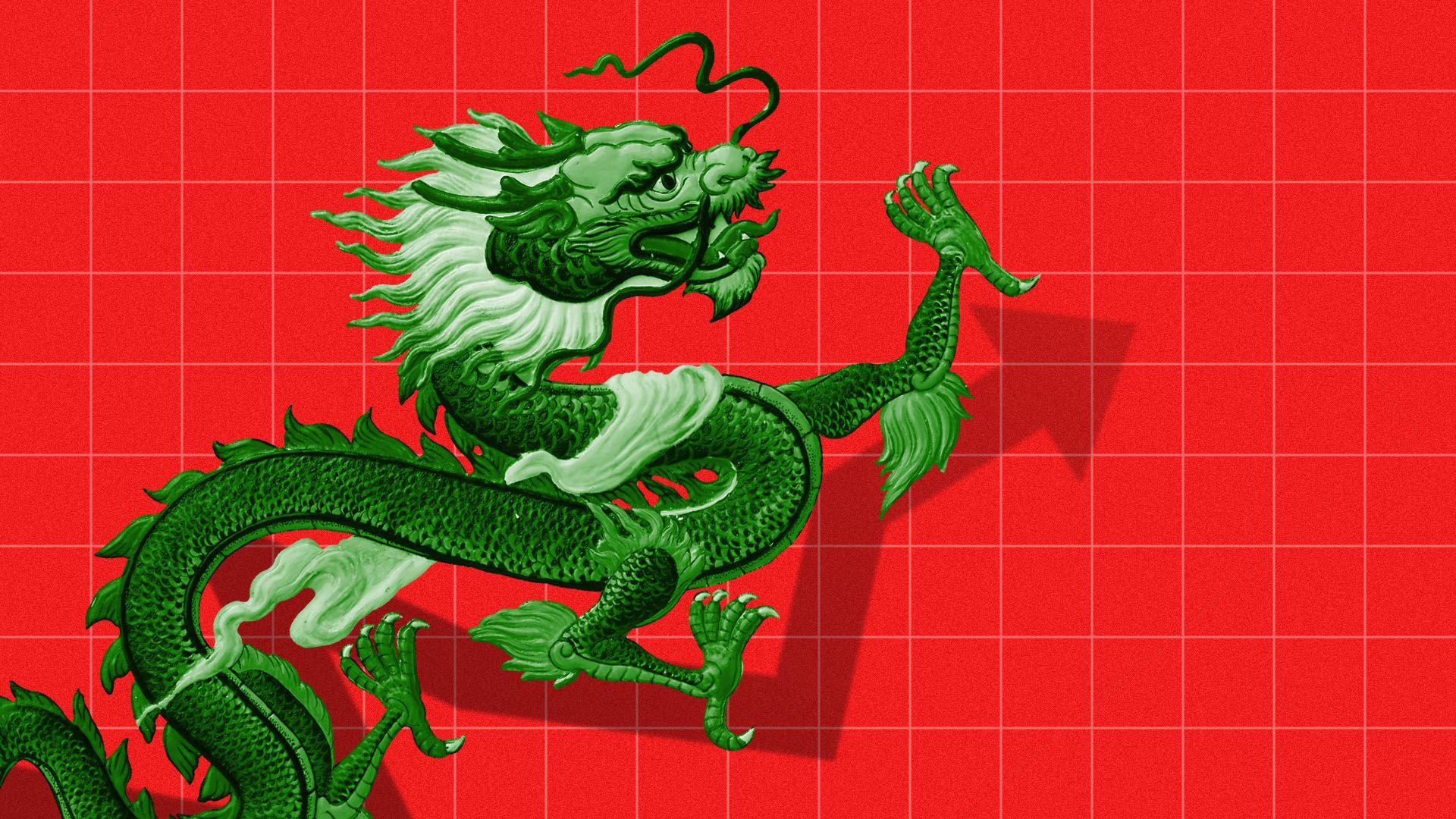| | | | | | | Presented By OurCrowd | | | | Axios Capital | | By Felix Salmon ·Nov 12, 2020 | | I waxed philosophical on Axios.com this morning, writing about how self-referential the news of Joe Biden's election was. - In this week's newsletter, I look at the differences between how the U.S. and Europe are approaching the current coronavirus wave; the weirdness that is the current stock market; Visa's status as a monopoly; the sale of Supreme; podcast wars; and much more. All in 1,800 words, a 7-minute read.
| | | | | | 1 big thing: America's coronavirus complacency |  | | | Illustration: Eniola Odetunde/Axios | | | | The second wave of COVID-19 presents new challenges and risks, but the blueprint for managing it is the same. Additional support would accelerate a recovery that is underway, but I wouldn't want to say at this point that it was necessary. The long-feared autumn spike in coronavirus cases has arrived, both in Europe and in the U.S. — and there's a huge difference in how the two regions are reacting. Europe is on an emergency footing, while America ... isn't. Why it matters: We've seen this movie before, and we've seen the need for coordinated government action, from public-health agencies to fiscal policy to monetary policy. That's happening in Europe. It's not happening here. The big picture: Europe has strict lockdowns in Ireland, the U.K., France, Spain, Poland, Austria, and the Czech Republic; the U.S. has strict lockdowns nowhere. - Europe is also taking unprecedented fiscal measures, collectively underwriting an $850 billion relief package for the bloc's poorest members.
- The European Central Bank is redoubling its efforts to maximize economic growth both now and in the future, and is working closely with fiscal authorities. Effectively, the ECB can rely on member-state governments to provide good public-sector jobs and unemployment benefits, clearing the way for the central bank to support the private sector.
In America, there's much less urgency and almost zero coordination. Lockdowns are limited to a handful of 10pm restaurant curfews, while economic policy has become irredeemably politicized along left-right lines. - A new Brookings report shows that Democrats and Republicans "represent radically different swaths of the economy" — and that the Republican Party "sees no reason to consider the priorities and needs of the nation's metropolitan centers," where most of service industries hit the hardest by the pandemic are based. (New York's theaters, for instance, will have been dark for well over a year when they finally reopen.)
- American policymakers, especially on the right, are also much more likely to to look to the stock market as an indicator of the health of the economy. The March plunge in stock prices helped catalyze the CARES Act; now that stocks are back near record highs, appetite for further stimulus has diminished considerably.
- The bond market has also weakened to the point at which bond yields have effectively made monetary conditions significantly tighter. The benchmark 10-year U.S. Treasury yield has risen from as low as 0.51% in August to 0.98% now. That's the equivalent of two full rate hikes, and it's not obvious what the Fed can do about it, or whether they're willing to do it.
The bottom line: Lockdowns can't last indefinitely. But the news that Pfizer has developed a successful vaccine means that the end of the beginning is in sight. - Aggressive government action can no longer be disparaged as merely delaying the inevitable; rather, it's a way of avoiding the worst until the vaccine arrives. But I still wouldn't bet on it happening.
|     | | | | | | Bonus: The state of the pandemic, in one chart |  |     | | | | | | 2. The stock market's ADHD |  | | | Illustration: Eniola Odetunde/Axios | | | | There might be times when stock market moves make sense, but this is not one of those times. Why it matters: High and volatile stock prices, while mostly harmless, reflect the febrile zeitgeist more than they do fundamental valuations. By the numbers: Shares of cannabis company Canopy Growth closed on Election Day at $20.46 apiece, valuing the company at $7.6 billion. - That evening, referendum results came in showing that recreational cannabis had been legalized in Arizona, Montana, New Jersey and South Dakota — a broad range of states, helping lay the groundwork for decriminalization at the federal level.
- The following day, Wednesday, Canopy's shares dropped as low as $18.32 — down 10.5%.
- By Friday, however, with no new news, the shares were as high as $24.98 — up 36% in 48 hours.
- The cannabis rally continued into Monday, because something something coronavirus vaccine, even as Peloton was seeing its valuation slashed by a quarter in a single day.
The market euphoria on Monday was so extreme that hedge fund manager Bill Ackman was able to replicate exactly the same credit default swap bet, at exactly the same prices, that he made in February — the one where he turned $27 million into $2.6 billion in the space of less than a month. - The pandemic is much more out of control now than it was in February, and everybody knows how far prices can fall, because we saw them do just that in the spring. Yet Ackman's counterparties don't seem to have learned anything from their February mistake.
Between the lines: A lot of momentum trades got severely unwound on Monday, with moves as large as 15 standard deviations, according to Nomura strategist Charlie McElligott. - It was almost certainly a day where fortunes were made and lost at long-short hedge funds. As the Wall Street Journal reports, "value stocks beat expensive growth stocks by the widest margin of any single day since the 1930s."
- Individual long-term buy-and-hold investors, however, were, as ever, perfectly fine ignoring the market entirely.
|     | | | | | | A message from OurCrowd | | Flying robots may save the ag industry billions annually | | |  | | | | Every year farmers lose billions of dollars when fruit is left to rot. Tevel's Flying Autonomous Robots deploy on-demand, harvesting fruit at its peak value, accurately and efficiently. Now, you have the chance to invest early. Explore Tevel's billion-dollar potential on OurCrowd. | | | | | | 3. Justice Department takes on a monopolist |  | | | Illustration: Annelise Capossela/Axios | | | | The Department of Justice antitrust lawsuit against Visa is important, not just for the outcome of a $5 billion fintech acquisition, but for the whole future of the industry. Why it matters: While there are a lot of financial startups, very few of them are genuinely disruptive. In fact, many of them implicitly rely upon the Visa and Mastercard duopoly. The DOJ wants to ensure that there's still a chance that duopoly could face real competition. How it works: Visa has a monopoly on debit purchases, and especially online debit purchases, where it has 70% of the market and earns $2 billion per year. - Plaid is one of the few companies in a position to develop a rival product — one where consumers could pay for purchases directly out of their bank account, much as they do when they use Venmo.
- Visa decided to buy Plaid as an "insurance policy to protect our debit biz in the U.S.," in the words of Visa's CEO. That's pretty clearly anticompetitive behavior.
The big picture: It's not just Visa that relies on revenue from debit-card purchases; it's also all the neobanks, such as Chime, Varo, Aspiration, and N26. - Chime's CEO, Chris Britt, likes to tell people that he's not a bank, he's a payments company.
- That means he's fully invested alongside Visa in having access to a continued stream of payments on Visa's rails, where Chime gets a cut of every transaction in a way that might not be the case with a rival product.
The bottom line: Payments tend by their nature to be monopolies. If there's hope for a competitor to Visa, it's good that the DOJ is keeping that hope alive. Even if that threatens the main income stream for other fintechs. |     | | | | | | 4. Multi-billion-dollar hypebeast |  | | | Illustration: Eniola Odetunde/Axios | | | | Supreme — a skatewear brand with 12 stores — has sold for $2.1 billion to VF Corporation, which already owns Vans as well as brands like Timberland and The North Face. Why it matters: VF Corp is putting a price on irony, and it might even have got itself a deal. Between the lines: As NYT columnist Vanessa Friedman writes, Supreme represents "an ironic meta-commentary on the culture of consumption for a generation that wanted to reject those trappings, while also exploiting that culture." - The very word "hypebeast" — the term for the fans who will line up for hours to get their hands on a limited-edition Supreme "drop" — is loaded with disdain yet also embraced.
- Supreme's customers are acutely aware that they are being exploited — they're in on the joke that they're also the butt of.
What they're saying: "Supreme has equity it can milk for at least 10 years," says Ana Andjelic, the author of "The Business of Aspiration." With VF's backing, she says, Supreme will find it easy to expand into markets where it currently has no footprint at all — Russia, Latin America, the Middle East, even much of Europe. (At the moment, Supreme is overwhelmingly found in the U.S. and Japan.) - VF is good at leaving its brands alone and helping them grow — Vans is growing even faster than Supreme. It has the scale and expertise to provide back-end support, especially in treacherous international markets, while remaining hands-off when it comes to the front-end design decisions.
The bottom line: Gen Xers like myself tend to think in terms of "selling out" — the idea that expansion necessarily means brand dilution. But it's not clear that modern brands work that way. - As Andy Warhol discovered in the 1960s, and artists from Yayoi Kusama to Takashi Murakami continue to discover to this day, sometimes expansion can enhance a brand, rather than dilute it.
- Supreme stole its logo from Barbara Kruger, who called the brand "a ridiculous fustercluck of totally uncool jokers." (She didn't actually say "fustercluck," but I didn't want this email to be caught by your spam filter.)
- The reason Supreme can grow without becoming uncool is that overpriced T-shirts were never really cool to begin with. There's a self-lacerating humor to their existence, which makes them collectible — a bit like KAWS. That's all that matters.
|     | | | | | | 5. Podcast wars |  | | | Illustration: Aïda Amer/Axios | | | | The podcast industry is in the midst of an acquisition frenzy, writes Axios' Sara Fischer. Why it matters: The past year has seen iHeartMedia, Apple, SiriusXM and others invest hundreds of millions of dollars in podcast acquisitions. The latest deal is Spotify spending $235 million on Megaphone, an adtech company specializing in targeted advertising. Driving the news: Spotify's Megaphone deal comes after iHeartMedia announced Friday it would acquire the rest of Voxnest, another podcast ad company. - SiriusXM's $325 million acquisition of Stitcher closed last month. That deal gave it access to Midroll, a podcast ad company Stitcher bought in 2015. This summer, the radio giant acquired Simplecast, a podcast management platform. It already owns podcast ad company AdsWizz, which it acquired through its purchase of Pandora in 2018.
The big picture: For now, podcasting is a small but growing advertising medium. The industry as a whole still only brings in less than $1 billion in ad revenue, even though more than 90 million people listen to podcasts monthly, per Edison Research. - Evidently, a significant chunk of that $1 billion is already ending up in the pockets of middlemen who connect advertisers with podcasters.
|     | | | | | | 6. Credit card balances dry up |  Data: TransUnion; Chart: Axios Visuals Americans' credit card balances are on a sustained decline for the first time since the financial crisis. By the numbers: Credit card balances peaked at $847 billion in the fourth quarter of 2019, per TransUnion. Since then, they've declined in three successive quarters, by a total of $124 billion. The bottom line: Even record economic growth in Q3 wasn't enough to turn this trend around. American consumers still haven't rediscovered their penchant for debt. |     | | | | | | 7. Coming up: Big Tech earnings in China |  | | | Illustration: Sarah Grillo/Axios | | | | JD.com and Baidu, two of China's biggest tech companies, release earnings on Monday. What to watch: Any commentary from execs around the tech antitrust rules proposed by Chinese regulators this week. - Worth noting: JD.com brought in roughly $50 billion during its Singles Day event, which stretched over 11 days this year. Rival Alibaba generated $74 billion in sales.
|     | | | | | | 8. Building of the week: Chips, Manchester |  | | | Photo: Christian Richters/View Pictures/Universal Images Group via Getty Images | | | | Will Alsop designed Chips (that's English for "fries," three of them, stacked one above the other) in 2002. It was built as low-cost housing, and a 2-bedroom apartment can still be bought for about $200,000. - Built next to a Manchester canal, the wood-clad building contains 142 apartments on eight levels, above an elevated ground floor.
- The 15,000-square-foot footprint was cleared by demolishing an old hospital and mill.
|     | | | | | | A message from OurCrowd | | Accurate, autonomous harvesting may save billions. You can invest now | | |  | | | | Fusing data and AI analysis, Tevel's Flying Autonomous Robots can harvest fruit efficiently and effectively. Partnering with a team of successful, strategic investors at OurCrowd, investing in Tevel is now open to accredited investors. Get in early on this new investment with OurCrowd. | | | | Thanks for reading! As ever, tell your friends to subscribe, for free, by clicking here. | | | | Axios thanks our partners for supporting our newsletters.
Sponsorship has no influence on editorial content. Axios, 3100 Clarendon Blvd, Suite 1300, Arlington VA 22201 | | | You received this email because you signed up for newsletters from Axios.
Change your preferences or unsubscribe here. | | | Was this email forwarded to you?
Sign up now to get Axios in your inbox. | | | | Follow Axios on social media:    | | | | | |
No comments:
Post a Comment